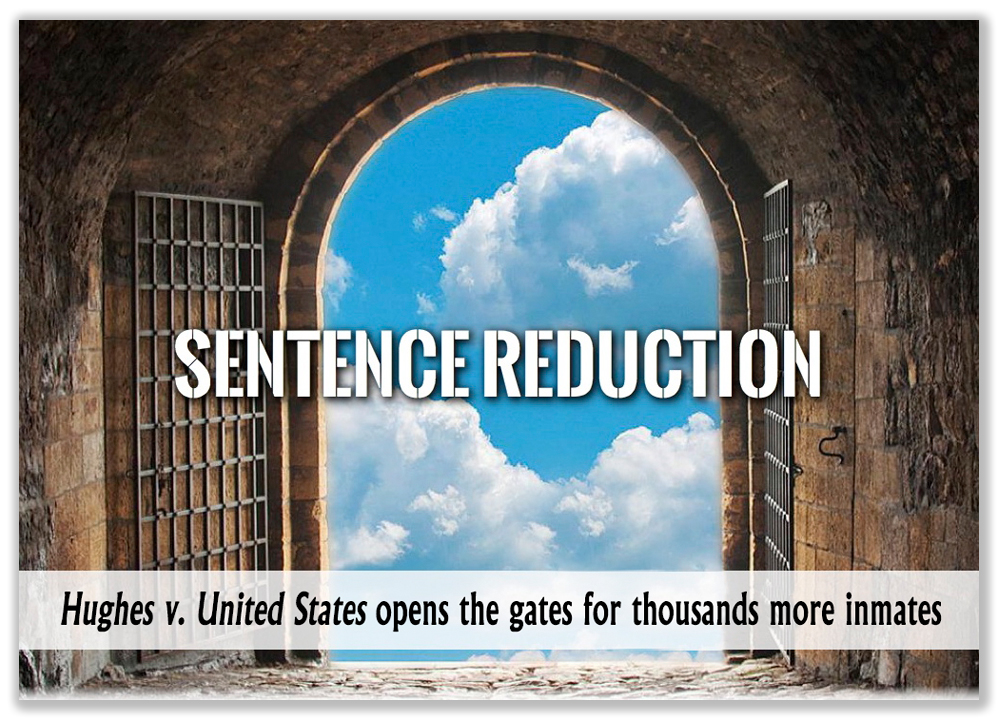We post news and comment on federal criminal justice issues, focused primarily on trial and post-conviction matters, legislative initiatives, and sentencing issues.

HUGHES DECISION BEGINS WORKING FOR 3582(c)(2) INMATES
The Supreme Court’s decision in Hughes v. United States last month is already getting sentence reductions for F.R.Crim.P. 11(c)(1)(C) plea agreement holders.
In a Rule 11(c)(1)(C), or “Type-C,” plea agreement, the defendant and Government agree on a particular sentence. The court may either accept the agreement, which requires it to impose that agreed-upon sentence, or reject the agreement in its entirety. What the court may not do is accept the agreement but deviate from the sentence. In standard, or Rule 11(c)(1)(A), plea agreements, the sentence may be recommended by the parties, but a determination of what sentence to impose is the prerogative of the court.
 The U.S. Sentencing Commission has reduced the drug quantity tables three times since 2007. In each case, the Commission made the reduction retroactive under Guideline 1B1.10. This meant that a 2006 defendant whose offense level was set at a Level 36 for the quantity of marijuana involved in her offense, and sentenced within the corresponding sentencing range of 188-235 months, could have applied for a reduction of sentence under 18 USC 3582(c)(2) based on the new, lower range for the same quantity of marijuana adopted in 2007. She would have then had a range of 151-188 months. By 2015, the accumulated reductions would have set her range at 121-151 months. An initial sentence of 188 months may have dropped by a third to as low as 121 months.
The U.S. Sentencing Commission has reduced the drug quantity tables three times since 2007. In each case, the Commission made the reduction retroactive under Guideline 1B1.10. This meant that a 2006 defendant whose offense level was set at a Level 36 for the quantity of marijuana involved in her offense, and sentenced within the corresponding sentencing range of 188-235 months, could have applied for a reduction of sentence under 18 USC 3582(c)(2) based on the new, lower range for the same quantity of marijuana adopted in 2007. She would have then had a range of 151-188 months. By 2015, the accumulated reductions would have set her range at 121-151 months. An initial sentence of 188 months may have dropped by a third to as low as 121 months.
Before Hughes, a defendant sentenced under a Rule 11(c)(1)(C) pies could not qualify for a reduction unless she could show that her sentence was “based on the Guidelines.” Proving that the Guidelines were the basis for a Type-C plea was a pretty tall order, because most of the time, the issue never arose. The sentence was pure negotiation, and the courts usually signed off without much comment.
In Hughes, the Supreme Court held that a sentence imposed pursuant to a Rule 11(c)(1)(C), or “Type-C” plea agreement, is typically based on the sentencing guideline range whether it says so or not because the district court almost always must first evaluate the stipulated sentence in light of the defendant’s sentencing guideline range. A sentence imposed pursuant to a Type–C agreement is based on the defendant’s Guidelines range so long as that range was part of the framework the district court relied on in imposing the sentence or accepting the agreement.
 Tremell Armsted had a Type-C plea agreement, and was denied an 18 USC 3582(c)(2) sentence reduction by the 5th Circuit last year. He filed for Supreme Court review, and his petition was held pending Hughes. After that decision, the Supreme Court sent him back to the 5th Circuit.
Tremell Armsted had a Type-C plea agreement, and was denied an 18 USC 3582(c)(2) sentence reduction by the 5th Circuit last year. He filed for Supreme Court review, and his petition was held pending Hughes. After that decision, the Supreme Court sent him back to the 5th Circuit.
The Circuit agreed that Tremell entered into a “Type- C” agreement “in which the parties agreed that the appropriate term of imprisonment was 180 months. At the sentencing hearing, the district court referred to the applicable guideline range that had been calculated by the probation officer and noted that it was lower than the stipulated sentence of 180 months. We conclude that Armstead’s sentence was ‘based on his guideline range because it was part of the framework the court relied upon in imposing his sentence.”
Tremell’s 3582(c)(2) motion was sent back to the district court for a decision on the merits.
United States v. Armsted, Case No. 17-30439 (5th Cir., July 19, 2018)
– Thomas L. Root

